Horrorpalooza 2: Electric BOOgaloo!
Yeah, yeah, I've been really lax on updates to the Dish lo, these last two (yipes!) months. Only the recent demise of the spellbinding Tamara Dobson (and the recent visit of the spellbinding Ms. Tura Satana) shook me outta my torpor.
It's not like I've been slumped in the Barca-Lounger mainlining Cheetos and Old English for the last sixty days. Life's been pretty tumultuous at home and work, plus the missus and I just got back from an adventurous two weeks in England. Rest assured, I'll bore you faithful readers (all six of you!) stiff with the details on the latter in the coming days/weeks. But it's that time of year again, when even the most fair-weather film lovers glom onto all things frightful and when I get the hubris to attempt a sustained stretch of written productivity.
I signed a pact with the devil in 2005 to do a Blog daily, for an extended stretch of October until Halloween, each entry devoted to that most cherished of my cinema mistresses--the horror film. So it is with pleasure that I bring back, by popular (at least with the two of you who sent huzzahs last year) demand, Horrorpalooza! The Petri Dish will contain one horror-related entry a day between now and All Hallows' Eve if it kills me.
Fortunately, some DVD issues make for sweet death, like the spanking new Classic Sci-Fi Ultimate Collection from MCA/Universal, which contains a quintet of 1950s classics never before released in the format. These technically qualify as science fiction flicks, but they possess more than enough horror movie qualities to merit Horrorpalooza inclusion (besides, it's my Blog, and I'll diverge if I wanna).
Like the label's Hammer Horror Collection Set from last year (which, ironically enough, kicked off Horrorpalooza '05), The Classic Sci-Fi Ultimate Collection offers crumbs for extras (again, just one trailer per movie). But just having pristine prints of these thrillers is enough, thanks.
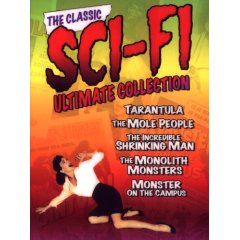 The jewel of the set, 1957's The Incredible Shrinking Man, sets up a potentially laughable central plot conceit (no ambiguities concealed in that title) and then promptly transcends it. While boating off the California coast, regular guy Scott Carey (Grant Williams) is exposed to a radioactive cloud.
The jewel of the set, 1957's The Incredible Shrinking Man, sets up a potentially laughable central plot conceit (no ambiguities concealed in that title) and then promptly transcends it. While boating off the California coast, regular guy Scott Carey (Grant Williams) is exposed to a radioactive cloud.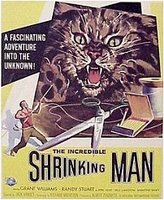 Carey notices his waistline--and stature--diminishing soon after his return to the mainland; somehow, the gamma rays he's been inundated with cause him to shrink at the rate of an inch a day.
Carey notices his waistline--and stature--diminishing soon after his return to the mainland; somehow, the gamma rays he's been inundated with cause him to shrink at the rate of an inch a day.
The genius here is in the details. Richard Matheson's literate and unsensationalized script focuses on the human toll of Carey's predicament throughout the first act: The fraying at the edges of his marriage; living in a proverbial fishbowl once the media discovers his affliction; his attempts at going on with life when an antidote temporarily stems his reduction; and profound self-reflection as he threatens to disappear from existance.
Don't assume, however, that The Incredible Shrinking Man is just a bunch of existential navel-gazing. Once Carey reaches doll-size and mundane realities like the family cat become literal monsters, director Jack Arnold plummets his hapless protagonist headlong into the realm of tense, survival-driven horror. Williams gives a great performance here: If science fiction wasn't so readily dismissed as kids' stuff by the mainstream of the era, the unheralded Universal contract player's natural and riveting work here might well have made him a star.
Williams resurfaces, albeit in a more stalwart and straightforward fashion, as the hero in The Monolith Monsters (also 1957). This time out, he's a geologist in a small southwest town dealing with meteorite fragments that grow limitlessly when exposed to water. Yep, the monsters here are basically extreme mutant forms of Magic Rocks, but again, the execution keeps things surprisingly tense and absorbing. And while The Monolith Monsters lacks Shrinking Man's thematic gravitas, I'm hard-pressed to think of a modern horror or sci-fi flick that manuevers around its budgetary limitations with such level-headed ingenuity. Good--and surprising--stuff.
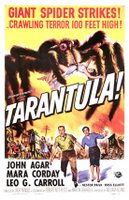 Tarantula, meanwhile, serves up a much more outwardly scary antagonist in the form of a scientifically-goosed mutant arachnid. Leo G. Carroll classes up this 1955 joint as a classic well-intentioned scientist whose experiments, targeted at ending world hunger, just end up inflating the title creature to a hundred feet of creepy-crawly menace. Tarantula doesn't quite measure up to that Lawrence of Arabia of giant bug movies, THEM!, but director Jack Arnold knows how to stir together mutant monster antics with a dose of Frankenstein-ian spookiness. Keep an eye out for Clint Eastwood, uncredited and buried in an oxygen mask and uniform as a jet fighter pilot.
Tarantula, meanwhile, serves up a much more outwardly scary antagonist in the form of a scientifically-goosed mutant arachnid. Leo G. Carroll classes up this 1955 joint as a classic well-intentioned scientist whose experiments, targeted at ending world hunger, just end up inflating the title creature to a hundred feet of creepy-crawly menace. Tarantula doesn't quite measure up to that Lawrence of Arabia of giant bug movies, THEM!, but director Jack Arnold knows how to stir together mutant monster antics with a dose of Frankenstein-ian spookiness. Keep an eye out for Clint Eastwood, uncredited and buried in an oxygen mask and uniform as a jet fighter pilot.
John Agar, Tarantula's strong-jawed hero, became cinematic comfort food throughout the 50's and 60's playing mostly, well, strong-jawed heroes, and he pulls in yet more hero duty in the loveably weird The Mole People. This 1956-vintage chiller finds Agar and fellow archaeologists Hugh Beaumont (yes, Ward Cleaver himself) and Nestor Paiva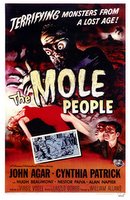 stumbling across a race of Sumerian albinos deep underneath the earth's surface. These pasty-faced ancients engage in ritual sacrifice and enslave of a race of scary, big-clawed mole men.
stumbling across a race of Sumerian albinos deep underneath the earth's surface. These pasty-faced ancients engage in ritual sacrifice and enslave of a race of scary, big-clawed mole men.
The bizarre opening sequence, with English professor Dr. Frank C. Baxter giving a meandering intro of Criswellian daffiness, sets the warped tone, and things just escalate from there. The Sumerians' underground universe combines the oddball aesthetics of a grade Z Mummy movie and a vintage episode of Star Trek, director Virgil Vogel keeps the whole mess zipping along at lightning pace, and the imaginative, gruesomely rendered mole people rate as some of Universal makeup man Bud Westmore's wildest creations. Plus, it's biologically impossible not to love a movie in which John Agar takes down swarms of bad guys with...a flashlight.
It's no secret that Universal generated these cheap-but-profitable formula flicks in direct competition with similarly cheap-but-profitable independent horror and sci-fi B movies of the day. Despite this, the Universal-released science-fiction films on this three-disc set demonstrate a bit more polish than their indie-bred rivals, with one entertainingly glaring exception. 1958's Monster on the Campus sports sloppy scripting and Grand-Canyon-sized gaps in logic to rival the most cheap and cheesy small-studio product, which makes it more unhealthily, indescribably delicious than a sopping-hot plate of 7-Eleven nachos.
Arthur Franz plays Dr. Donald Blake, a classic pipe-puffing college anthropology professor who's just received a freshly-caught prehistoric fish (a coelacanth, in case you're keeping score) for study. What Blake doesn't know (and is far too thick-witted to discover until 3/4 of the way through the film) is that the fish's blood causes any organism that consumes it to regress to a prehistoric state.
A puddle of the fish-plasma-filled water ends up outside his classroom during transit, so one student's friendly German Shepherd takes a drink of the bloody fluid and becomes a savage Antideluvian Wolf (complete with extra-large plastic fangs). Later, a dragonfly lands on the coelocanth and grows to the size of an albatross.
If you're doing your B-movie algebra up to this point, then you've surely ascertained that it's only a matter of time before a human being gets exposed to the blood, leading to a specific equation: Prehistoric Mutant Fish Blood plus Human Being times Absurd Coincidence equals Monster. And if you're thinking that the human in said equation will unequivocally be the Doctor, give yourself a bright shiny quarter, li'l shaver.
Blake slices open his finger on the coelacanth's sharp teeth while carrying in the fish the first time, submerges his hand in fish-blood-saturated water, and then reflexively sucks his bleeding wound(??!?!).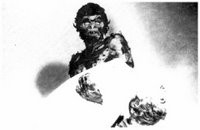 That night he turns into a troglydyte with shoulderpads, sporting what looks like a rubber ape mask topped by a Jim Morrison wig. Cave-Blake goes all homicidal on his flirtatious assistant (that's what she gets for putting the make on an engaged man), then wakes up oblivious to the previous evening's shenanigans.
That night he turns into a troglydyte with shoulderpads, sporting what looks like a rubber ape mask topped by a Jim Morrison wig. Cave-Blake goes all homicidal on his flirtatious assistant (that's what she gets for putting the make on an engaged man), then wakes up oblivious to the previous evening's shenanigans.
Since the regression is only temporary, screenwriter David Duncan scrapes together a truly mind-boggling set of circumstances to repeatedly re-infect the doctor and prolong his primieval rampage (at one point--I swear to God--the doc accidentally smokes coelacanth blood in his trusty pipe). And this being a fifties sci-fi flick, this low-rent Dr. Jekyll's gotta pay the moral toll and take a fall.
More so than any of the movies on this set, Monster on the Campus provides grade Z fun of the most artless and goofy kind, so the fact that it's also directed by Incredible Shrinking Man helmsman Jack Arnold probably seems a bit ironic. Then again, Arnold led a journeyman career behind the camera, directing several episodes of Gilligan's Island and The Brady Bunch (among others) throughout the sixties and seventies. That's a revelation more surreal than all of Arnold's sci-fi thrillers put together.
It's not like I've been slumped in the Barca-Lounger mainlining Cheetos and Old English for the last sixty days. Life's been pretty tumultuous at home and work, plus the missus and I just got back from an adventurous two weeks in England. Rest assured, I'll bore you faithful readers (all six of you!) stiff with the details on the latter in the coming days/weeks. But it's that time of year again, when even the most fair-weather film lovers glom onto all things frightful and when I get the hubris to attempt a sustained stretch of written productivity.
I signed a pact with the devil in 2005 to do a Blog daily, for an extended stretch of October until Halloween, each entry devoted to that most cherished of my cinema mistresses--the horror film. So it is with pleasure that I bring back, by popular (at least with the two of you who sent huzzahs last year) demand, Horrorpalooza! The Petri Dish will contain one horror-related entry a day between now and All Hallows' Eve if it kills me.
Fortunately, some DVD issues make for sweet death, like the spanking new Classic Sci-Fi Ultimate Collection from MCA/Universal, which contains a quintet of 1950s classics never before released in the format. These technically qualify as science fiction flicks, but they possess more than enough horror movie qualities to merit Horrorpalooza inclusion (besides, it's my Blog, and I'll diverge if I wanna).
Like the label's Hammer Horror Collection Set from last year (which, ironically enough, kicked off Horrorpalooza '05), The Classic Sci-Fi Ultimate Collection offers crumbs for extras (again, just one trailer per movie). But just having pristine prints of these thrillers is enough, thanks.
 The jewel of the set, 1957's The Incredible Shrinking Man, sets up a potentially laughable central plot conceit (no ambiguities concealed in that title) and then promptly transcends it. While boating off the California coast, regular guy Scott Carey (Grant Williams) is exposed to a radioactive cloud.
The jewel of the set, 1957's The Incredible Shrinking Man, sets up a potentially laughable central plot conceit (no ambiguities concealed in that title) and then promptly transcends it. While boating off the California coast, regular guy Scott Carey (Grant Williams) is exposed to a radioactive cloud. Carey notices his waistline--and stature--diminishing soon after his return to the mainland; somehow, the gamma rays he's been inundated with cause him to shrink at the rate of an inch a day.
Carey notices his waistline--and stature--diminishing soon after his return to the mainland; somehow, the gamma rays he's been inundated with cause him to shrink at the rate of an inch a day.The genius here is in the details. Richard Matheson's literate and unsensationalized script focuses on the human toll of Carey's predicament throughout the first act: The fraying at the edges of his marriage; living in a proverbial fishbowl once the media discovers his affliction; his attempts at going on with life when an antidote temporarily stems his reduction; and profound self-reflection as he threatens to disappear from existance.
Don't assume, however, that The Incredible Shrinking Man is just a bunch of existential navel-gazing. Once Carey reaches doll-size and mundane realities like the family cat become literal monsters, director Jack Arnold plummets his hapless protagonist headlong into the realm of tense, survival-driven horror. Williams gives a great performance here: If science fiction wasn't so readily dismissed as kids' stuff by the mainstream of the era, the unheralded Universal contract player's natural and riveting work here might well have made him a star.
Williams resurfaces, albeit in a more stalwart and straightforward fashion, as the hero in The Monolith Monsters (also 1957). This time out, he's a geologist in a small southwest town dealing with meteorite fragments that grow limitlessly when exposed to water. Yep, the monsters here are basically extreme mutant forms of Magic Rocks, but again, the execution keeps things surprisingly tense and absorbing. And while The Monolith Monsters lacks Shrinking Man's thematic gravitas, I'm hard-pressed to think of a modern horror or sci-fi flick that manuevers around its budgetary limitations with such level-headed ingenuity. Good--and surprising--stuff.
 Tarantula, meanwhile, serves up a much more outwardly scary antagonist in the form of a scientifically-goosed mutant arachnid. Leo G. Carroll classes up this 1955 joint as a classic well-intentioned scientist whose experiments, targeted at ending world hunger, just end up inflating the title creature to a hundred feet of creepy-crawly menace. Tarantula doesn't quite measure up to that Lawrence of Arabia of giant bug movies, THEM!, but director Jack Arnold knows how to stir together mutant monster antics with a dose of Frankenstein-ian spookiness. Keep an eye out for Clint Eastwood, uncredited and buried in an oxygen mask and uniform as a jet fighter pilot.
Tarantula, meanwhile, serves up a much more outwardly scary antagonist in the form of a scientifically-goosed mutant arachnid. Leo G. Carroll classes up this 1955 joint as a classic well-intentioned scientist whose experiments, targeted at ending world hunger, just end up inflating the title creature to a hundred feet of creepy-crawly menace. Tarantula doesn't quite measure up to that Lawrence of Arabia of giant bug movies, THEM!, but director Jack Arnold knows how to stir together mutant monster antics with a dose of Frankenstein-ian spookiness. Keep an eye out for Clint Eastwood, uncredited and buried in an oxygen mask and uniform as a jet fighter pilot.John Agar, Tarantula's strong-jawed hero, became cinematic comfort food throughout the 50's and 60's playing mostly, well, strong-jawed heroes, and he pulls in yet more hero duty in the loveably weird The Mole People. This 1956-vintage chiller finds Agar and fellow archaeologists Hugh Beaumont (yes, Ward Cleaver himself) and Nestor Paiva
 stumbling across a race of Sumerian albinos deep underneath the earth's surface. These pasty-faced ancients engage in ritual sacrifice and enslave of a race of scary, big-clawed mole men.
stumbling across a race of Sumerian albinos deep underneath the earth's surface. These pasty-faced ancients engage in ritual sacrifice and enslave of a race of scary, big-clawed mole men.The bizarre opening sequence, with English professor Dr. Frank C. Baxter giving a meandering intro of Criswellian daffiness, sets the warped tone, and things just escalate from there. The Sumerians' underground universe combines the oddball aesthetics of a grade Z Mummy movie and a vintage episode of Star Trek, director Virgil Vogel keeps the whole mess zipping along at lightning pace, and the imaginative, gruesomely rendered mole people rate as some of Universal makeup man Bud Westmore's wildest creations. Plus, it's biologically impossible not to love a movie in which John Agar takes down swarms of bad guys with...a flashlight.
It's no secret that Universal generated these cheap-but-profitable formula flicks in direct competition with similarly cheap-but-profitable independent horror and sci-fi B movies of the day. Despite this, the Universal-released science-fiction films on this three-disc set demonstrate a bit more polish than their indie-bred rivals, with one entertainingly glaring exception. 1958's Monster on the Campus sports sloppy scripting and Grand-Canyon-sized gaps in logic to rival the most cheap and cheesy small-studio product, which makes it more unhealthily, indescribably delicious than a sopping-hot plate of 7-Eleven nachos.
Arthur Franz plays Dr. Donald Blake, a classic pipe-puffing college anthropology professor who's just received a freshly-caught prehistoric fish (a coelacanth, in case you're keeping score) for study. What Blake doesn't know (and is far too thick-witted to discover until 3/4 of the way through the film) is that the fish's blood causes any organism that consumes it to regress to a prehistoric state.
A puddle of the fish-plasma-filled water ends up outside his classroom during transit, so one student's friendly German Shepherd takes a drink of the bloody fluid and becomes a savage Antideluvian Wolf (complete with extra-large plastic fangs). Later, a dragonfly lands on the coelocanth and grows to the size of an albatross.
If you're doing your B-movie algebra up to this point, then you've surely ascertained that it's only a matter of time before a human being gets exposed to the blood, leading to a specific equation: Prehistoric Mutant Fish Blood plus Human Being times Absurd Coincidence equals Monster. And if you're thinking that the human in said equation will unequivocally be the Doctor, give yourself a bright shiny quarter, li'l shaver.
Blake slices open his finger on the coelacanth's sharp teeth while carrying in the fish the first time, submerges his hand in fish-blood-saturated water, and then reflexively sucks his bleeding wound(??!?!).
 That night he turns into a troglydyte with shoulderpads, sporting what looks like a rubber ape mask topped by a Jim Morrison wig. Cave-Blake goes all homicidal on his flirtatious assistant (that's what she gets for putting the make on an engaged man), then wakes up oblivious to the previous evening's shenanigans.
That night he turns into a troglydyte with shoulderpads, sporting what looks like a rubber ape mask topped by a Jim Morrison wig. Cave-Blake goes all homicidal on his flirtatious assistant (that's what she gets for putting the make on an engaged man), then wakes up oblivious to the previous evening's shenanigans.Since the regression is only temporary, screenwriter David Duncan scrapes together a truly mind-boggling set of circumstances to repeatedly re-infect the doctor and prolong his primieval rampage (at one point--I swear to God--the doc accidentally smokes coelacanth blood in his trusty pipe). And this being a fifties sci-fi flick, this low-rent Dr. Jekyll's gotta pay the moral toll and take a fall.
More so than any of the movies on this set, Monster on the Campus provides grade Z fun of the most artless and goofy kind, so the fact that it's also directed by Incredible Shrinking Man helmsman Jack Arnold probably seems a bit ironic. Then again, Arnold led a journeyman career behind the camera, directing several episodes of Gilligan's Island and The Brady Bunch (among others) throughout the sixties and seventies. That's a revelation more surreal than all of Arnold's sci-fi thrillers put together.


Comments
Ah, the fabulous power of ... Radiation!